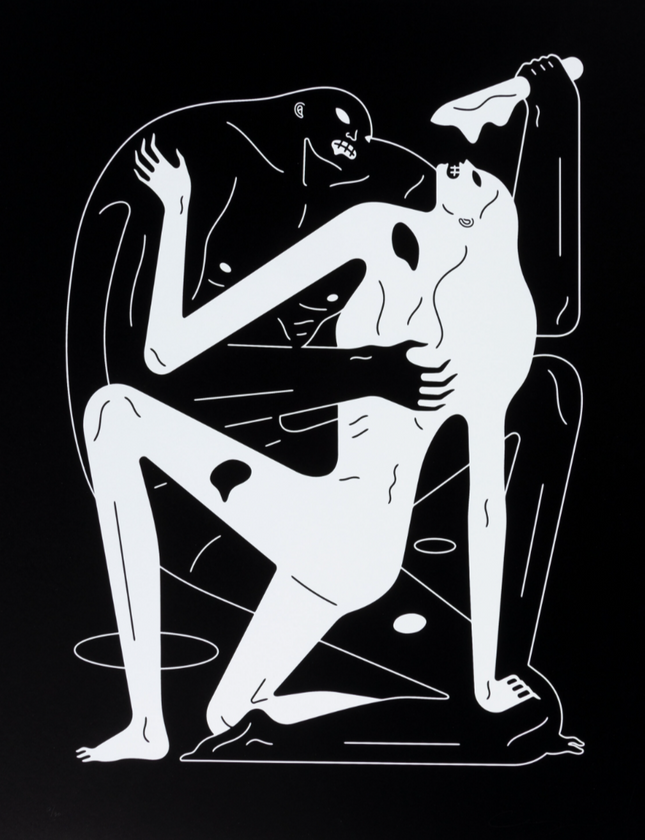
Stabbing & Backstabbing

Cleon Peterson The Tempest Silkscreen Print by Cleon Peterson
The Tempest Silkscreen Print by Cleon Peterson Hand-Pulled 1-Color on 370gsm Legion Sirio Ultrablack Fine Art Paper Limited Edition Artwork. 2021 Signed by Cleon Peterson & Numbered Limited Edition of 30 Artwork Size 24x30 Silkscreen Print Published by Louis Buhl & Co. Signed, Dated, And Numbered In Pencil Along Lower Edge. The Provocative Essence of The Tempest in Street Pop Art In the tapestry of street pop art, few works stir the pot of social commentary as vigorously as Cleon Peterson's "The Tempest." This hand-pulled silkscreen print, manifested on the decadent 370gsm Legion Sirio Ultrablack fine art paper, is a limited edition creation that delves deep into the dissonance of human nature and societal conflict. Completed in 2021, this piece is part of a limited series, with only 30 pieces decorated with Peterson's signature and a unique number denoting its place in this exclusive release. With dimensions of 24x30 inches, "The Tempest" commands presence, drawing the eye and the mind into a discourse that is quintessential to the ethos of street pop art and graffiti artwork. Peterson's work is not for the faint of heart. It's a visual punch, unapologetic and blunt in its depiction of the darker facets of humanity. "The Tempest" is a testament to this unabashed bravery, presenting a dichotomy of black and white that goes beyond color, delving into the dualities of power and subjugation, order and chaos. The starkness of the monochrome palette is a deliberate choice, reflective of the clear-cut division in the societal structures that Peterson often critiques through his art. The absence of color is a strategic silence, allowing the narrative of domination and resistance to resonate louder with its audience. Street Pop Art and Its Dialogues on the Concrete Canvas Street pop art, an umbrella under which "The Tempest" finds a comfortable abode, is not merely an artistic expression but a conversation carved on the concrete canvas of public spaces. Peterson takes this dialogue to the exclusivity of fine art paper, bringing the rawness of the streets into the galleries and collections of art lovers. This transition is not just a physical one; it's a migration of ideas, a movement that brings the unrefined and often uncomfortable truths of graffiti artwork into a space that commands contemplation and discussion. Peterson's "The Tempest" allure is magnified by its rarity. In the art collection world, a piece's value is often tied to its scarcity. A limited edition of 30 ensures that only a few can claim ownership of this tangible slice of Peterson's vision. The meticulous process of hand-pulling each print and the high-quality paper choice elevate "The Tempest" from mere street art replication to a collectible piece of cultural significance. The collaboration with Louis Buhl & Co. for publication furthers this narrative, lending an air of prestige and ensuring the legacy of the artwork within the echelons of high art. Cleon Peterson's Challenge to the Viewer "The Tempest" is a challenge laid bare by Cleon Peterson. It's a gauntlet thrown at the feet of society, asking the viewer not just to observe but to engage with the underlying themes of strife and control. The dialogue initiated by this piece is a hallmark of street pop art and graffiti artwork, which have long been mediums for social and political discourse. Peterson's commitment to these themes is unwavering, and his ability to convey them through the silkscreen medium is a testament to his artist skill and understanding of his role as a provocateur in the art world. In conclusion, Cleon Peterson's "The Tempest" is a resonant piece that captures the essence of street pop art and graffiti artwork through its thematic boldness and visual impact. The hand-pulled silkscreen on fine art paper, limited to a select thirty prints, transcends the boundaries of traditional street art to enter the realm of fine art collection while still retaining the raw, unfiltered dialogue that defines the genre. It is a piece that stands as a bridge between the ephemeral nature of graffiti and the lasting impact of fine art, a bridge that Peterson navigates with deft skill and audacious honesty.
$5,000.00


